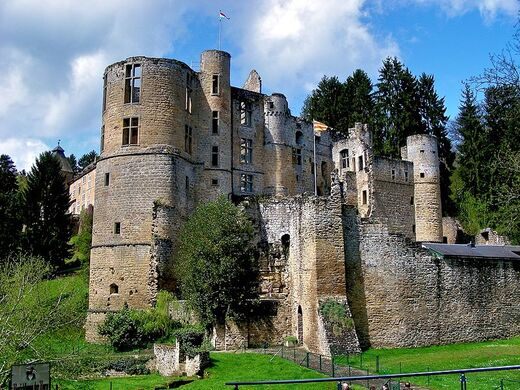TIPS LUXEMBOURG
1. Gas. Easily the cheapest in Europe (apparently Poland is the same) at €1.06.6, don’t fill up before coming here. There are two types of diesel: ordinary at the above price and Dynamic for high performance or large vehicles for .10 more.
2. French is the language of choice.
3. McDonald’s. The prices are extreme: €4.35 for the signature burgers (no fries or drink) and €2.25 for the small sundae that was €1 in Germany, €1.50 donut. The only deal was the small coffee at €1.
Especially in the winter when it is so cold, I spend my evenings and early mornings here mooching the internet. The only things I buy are small coffees and sundaes. I never eat at McDonald’s when at home and wouldn’t here, it is simply not that good. But the wi-fi is generally dependable and free. Even when I buy nothing, nobody bothers me. Most have good plugs.
But you wouldn’t know it by how busy they are in Europe. These prices are cheap by European standards. It was even packed in high-end Luxembourg. At 3 am, this place was packed with older teenagers and 20-somethings.
January 24 was the coldest day of the trip and the first that didn’t get above zero. At -6°C at night, it was chilly but comfortable with an extra fleece blanket and turning the heat on in the back. I could have this going all night.
NORTH LUXEMBOURG
I came from Trier, Germany, and decided to explore the north of the country first. I had a huge drive-about seeing all the NM sites (many castles). Luxembourg is quite hilly with forests, deep valleys, and farmland. In a very well-off country, the houses reflect the wealth – all large, plastered, nice styles and often painted in nice pastel shades. Nomad Mania has a mess of “castles” to see and a few churches. Most of the “country” roads I drove were very narrow two-lane, also plied by many huge public transportation buses, all empty – you almost had to come to a stop to pass safely.
ECHTERNACH (pop 4,600) is a commune with town status in eastern Luxembourg near the border with Germany and is the oldest town in Luxembourg. This small city is about a 23 km drive from Trier Germany.
History. The town grew around the Abbey of Echternach, which was founded in 698 by St Willibrord, an English monk from Ripon, Northumbria England, who became the first bishop of Utrecht and worked to Christianize the Frisians. As bishop, he was the Echternach monastery’s abbot until he died in 739.
The river Sauer that flows past the town now forms the border between Luxembourg and Germany. The Roman villa at Echternach (traces of which were rediscovered in 1975) was reputed to be the largest North of the Alps.
Willibrord’s buildings burned down in 1017 but the Romanesque basilica, with its symmetrical towers, to this day houses Willibrord’s tomb in its crypt. The abbey’s library and scriptorium had a European reputation. As it flourished, the town of Echternach grew around the abbey’s outer walls and was granted a city charter in 1236. The abbey was rebuilt in a handsome Baroque style in 1737. In 1797, in the wake of the French Revolution, the monks were dispersed and the abbey’s contents and its famous library were auctioned off. Some of the library’s early manuscripts, such as the famous Echternach Gospels are now in the Bibliothèque Nationale in Paris. In the 19th century, a porcelain factory was established in the abbey and the town declined until the advent of the railroad brought renewed life and an influx of tourists.
During the concluding months of World War II in Europe, on December 16, 1944, Echternach served as the southernmost point on the battlefront for the attempt of the German Wehrmacht forces attacking the Allies to retake Antwerp, during the Battle of the Bulge. The town was badly damaged in World War II but was thoroughly restored.
There are two main churches in Echternach. The larger is the Abbey’s Basilica of St Willibrord, now surrounded by the eighteenth-century abbey (today a high school) and is located in the heart of the town’s historical centre.
Echternack Benedictine Abbey. It was founded in 798 by St Willibrod (658-739), The abbey is presently a school and can’t be visited. Attached to one side is Saint Willibrod Basilica, a rather unadorned church. St Willibrod’s tomb is in the Crypt – a simple stone coffin housed in a dramatic white plaster cathedral.
Beaufort Renaissance Castle dates from the 11th century and consists of the ruins of the medieval fortress and an adjacent Renaissance château. It was probably in the 11th century that the castle began as a small square-shaped fortress on a large rock protected by a moat and a second wall above the valley. A keep was added and the gate was moved and enlarged. In 1348, the property came into the hands of the House of Orley after Adelaide of Beaufort married William of Orley. The Lords of Orley made significant extensions overlooking the valley.
After being ruined by the Thirty Years War and after 1781, was abandoned, fell into disrepair and at the beginning of the 19th century was even used as a quarry. In 1893, the new owner restored the new building, cleared the rubble away and opened the medieval castle to visitors. In 1981, the property was acquired by the State.
The ruins of the medieval castle are open to visitors every day from Easter until 1 November from 9 am to 6 pm.
Larochette (pop 1360). In the NM “small town” series, it is situated on the White Ernz River. The town is dominated by the partly ruined Larochette Castle. Meysembourg Castle, located some 2kms SW of Larochette, has a history dating back to the 12th century. Today’s castle was built in 1880 in the Neo-Renaissance style and is privately owned.
Heisdorf Castle is in the village of Heisdorf in central Luxembourg and was built by Baron Lippmann in the late 19th century. Surrounded by a large park, in 1916, the Sisters of the Christian Doctrine acquired the property as a convalescent home for their community. In 1982, it was opened as an old people’s home and in 2007, a new wing was added.
The castle grounds include a large park, along the main road, from which it is separated by a high wall. The park was renovated after 1910, which left the old trees standing. Two of these, a black pine and an oak tree, are counted among the “notable trees” of Luxembourg.
Schoenfels Castle. Another NM castle, Google Maps could only find a castle in a town by this name 597kms away and it would have been closed by the time I got there!
The hamlet of Schoenfels is first mentioned in 846. In the 12th Century, a fortified farm (primitive castle) was erected. It was of no great strategic value and was stripped of its fortifications by the French Army in 1683.
At present, the renovation of the tower is underway. The plan is to install a visitor centre as well as the offices of the Water & Forestry Administration.

Ettelbrück (pop 6,191). Another NM “small town”, is a commune with town status. At 5 pm there was a massive traffic bottleneck. There was nothing obvious dramatic to see.
DIERKIRCH (pop 6.080)
On the banks of the Sauer River, it is home to a brewery of national importance carrying the town’s name. The town is home to the national operational headquarters of the Luxembourgish Army. The town’s mascot is the donkey and there is a donkey fountain in the centre of Diekirch.
History. In the famous Battle of the Bulge, it was here that the river Sauer was crossed on the night of January 18, 1945, by the US 5th Infantry Division.
St Laurence Church. The town received its name in the 8th century when Charlemagne resettled the Saxons to bring them under his control. To convert the pagan Saxons to Christianity, a church was built, which gave the settlement its name: “Diet-Kirch” (“people’s church”).
In the course of extensive excavation in the 1960s, it was shown that the St. Laurence church is a Roman building. In the early 20th century, wall ruins and mosaics were being found north of the town centre. Archaeological investigations in 1992-1993, 1999 and 2008 enabled the reconstruction of a large Roman villa, which extended over all the land of the medieval town and was abandoned in the early 5th century.
National Museum of Military History.
After sleeping at a McDonald’s in Dierkirck with no wifi, I continued my drive through north Luxembourg. On a very overcast day, whenever I climbed out of the valleys, I was in dense clouds with massive wind turbines looming into the mist.
VIANDEN (pop 1,800). Vianden lies on the Our River, near the border between Luxembourg and Germany. It is known for its impressive castle and beautiful location in the Our Valley.
History. The origins date back to the Gallo-Roman age when there was a castellum on the site of the present castle. The original name of Vianden was Viennensis. The valley was covered in vineyards in Roman times. In the Middle Ages, Vianden’s craftsmen were recognized for their skills as tanners, drapers, weavers, barrel makers, masons, locksmiths, and goldsmiths. In 1490, they created guilds for their various trades. Over the years pig farming and leather making became the major industry but the tanneries finally closed in the mid-1950s.
Vianden is also remembered as the site of multiple battles in World War II. In November 1944 it saw fierce combat between the Luxembourg Resistance and German forces. It was the last place in Luxembourg to be freed from the Germans in February 1945 when the Americans completed Luxembourg’s liberation. A memorial to the west of the town, overlooking the castle, commemorates this final battle.
Vianden is a popular tourist destination with tens of thousands of visitors every year, especially from the Netherlands, Belgium, and Germany, with 14 hotels, four campsites and a youth hostel. The economy is however not without problems. While the hydroelectric pumping plant continues, directly and indirectly, to employ the local population, the closure of the Electrolux plant a couple of years ago has resulted in a considerable loss of jobs. There is a pleasant cycle route up the Sauer and Our valleys to Vianden and there are many signposted walks in the area.
Vianden Castle was built between the 11th and 14th centuries but with the departure of the Counts of Luxembourg to the Netherlands combined with the effects of fire and an earthquake, it slowly deteriorated. The final blow came in 1820 when William I of the Netherlands sold it to a local merchant who in turn sold off its contents and masonry piecemeal, reducing it to ruin. The chapel was restored in 1849 and during one of his visits to the town Victor Hugo lived in the castle for three months in 1871. Not until 1977, when it was ceded to the State, was it possible to undertake large-scale work, most of which has now been completed.

Church of the Trinitarians. Built entirely in 1248, the church of the Trinitarians is one of the finest expressions of Gothic art in Luxembourg with two parallel naves and the adjacent cloister. The large choir was added in 1644. Highlights are the main 1758 Rococo-style altar, the cloister of the Trinitarians and the recumbent effigy of Marie de Spanheim (approx. 1400), the last descendant of the Counts of Vianden.
The Cross of Justice is close to the Church of the Trinitarians recalling the chartering of Vianden by Philip II in 1308.
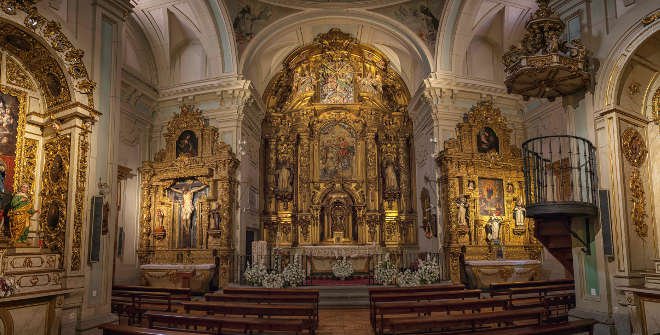
Another 17km detour out and back from Diebkirch, Vianden is a small village hugging a narrow valley circling the castle looming above.
Bourscheid Castle. The medieval castle stands on a site with archeological evidence of structures dating back to Roman times. Standing some 150 metres (490 ft) above the River Sûre, it is enclosed by a circular wall with 11 watchtowers.
There is no town here, just another big castle with round turrets and a square tower.

Clerveaux. Another NM “small town”, was quite out of the way in the very north of the country (22kms each way) so this is the one place in Luxembourg I didn’t see.
Esch-sur-Sure. A 2km detour, this small village sits on a tight bend of the river. Houses climb the hill to the church. Don’t drive up here, it is all one way, very narrow streets. This tiny stone church looks like it has not been used for decades but sits in an imposing place with great views down to the town and river.

Chateau de Wilz. It now holds a Campus of Applied Sciences, the tourism office and two museums: the Museum of the Battle of the Ardennes and an art museum.
Chateau de Colpach. An NM “small town, it is in the far west of the country against the Belgium border and a significant detour. Finding the “chateau” was a challenge. It is not used, is badly in need of paint and is behind a rehabilitation centre. Looking through the windows, there was a lot of wood panelling and wood floors and looked in good shape.
Grande Chateau d’Ansembourg. With one long building and two smaller “houses”, the highlight is the terraced gardens with two pools, a sculpture walk and elaborate hedges.
LUXEMBOURG CITY (pop 120,000)
The capital city of the Grand Duchy of Luxembourg (also named “Luxembourg”), it stands at the confluence of the Alzette and Pétrusse Rivers in southern Luxembourg at the heart of Western Europe, 213 km from Brussels, 372 km from Paris, and 209 km from Cologne.

In 2011, Luxembourg was ranked as having the second-highest per capita GDP in the world at $80,119 (PPP), with the city having developed into a banking and administrative centre. In the 2011 Mercer worldwide survey of 221 cities, Luxembourg was placed first for personal safety while it was ranked 19th for quality of living.
Luxembourg is one of the de facto capitals of the European Union (alongside Brussels and Strasbourg), as it is the seat of the European Court of Justice, the European Court of Auditors, the Secretariat of the European Parliament, the European Investment Bank, the European Investment Fund, and the European Stability Mechanism.
History. In the Roman era, a fortified tower guarded the crossing of two Roman roads that met at the site of Luxembourg City. In 963, Siegfried I of the Ardennes acquired the feudal lands of Luxembourg and built his castle, named Lucilinburhuc (“small castle”), on the Bock Fiels (“rock”). In 987, Archbishop Egbert of Trier consecrated five altars in the Church of the Redemption (today St. Michael’s Church). At a Roman road intersection near the church, a marketplace appeared around which the city developed.
The city, because of its location and natural geography, has throughout history been a place of strategic military significance. The first fortifications were built as early as the 10th century. By the end of the 12th century, as the city expanded westward around the new St. Nicholas Church (today the Cathedral of Notre Dame), new walls were built that included an area of 5 hectares (12 acres). In about 1340, new fortifications were built that stood until 1867.
In 1443, the Burgundians conquered Luxembourg. Luxembourg became part of the Burgundian, and later Spanish and Austrian empires and was repeatedly strengthened so that by the 16th century, Luxembourg itself was one of the strongest fortifications in Europe. Subsequently, the Burgundians, the Spanish, the French, the Spanish again, the Austrians, the French again, and the Prussians conquered Luxembourg.
Spain built 23 km of tunnels, starting in 1644 that were then enlarged under French rule by Marshal Vauban, and augmented again under Austrian rule in the 1730s and 1740s.
During the French Revolutionary Wars, the city was occupied by France twice: once, briefly, in 1792–3, and, later, after a seven-month siege. Luxembourg held out for so long under the French siege that French politician and military engineer Lazare Carnot called Luxembourg “the best fortress in the world, except Gibraltar”, giving rise to the city’s nickname: the ‘Gibraltar of the North.
The 1867 Treaty of London required Luxembourg to dismantle the fortifications in Luxembourg City. Their demolition took sixteen years, cost 1.5 million gold francs, and required the destruction of over 24 km (15 mi) of underground defences and 4 hectares (9.9 acres) of casemates, batteries, and barracks.
When, in 1890, Grand Duke William III died without any male heirs, the Grand Duchy passed out of Dutch hands, it became a truly independent country and became the capital of a fully independent state.
Despite Luxembourg’s best efforts to remain neutral in the First World War, it was occupied by Germany on 2 August 1914. In 1940, Germany occupied Luxembourg again and gradually integrated Luxembourg into the Third Reich. Luxembourg City was liberated on 10 September 1944. The city was under long-range bombardment by the German V-3 cannon in December 1944 and January 1945.
Geography. The city centre occupies a picturesque site on a salient, perched high on precipitous cliffs that drop into the narrow valleys of the Alzette and Pétrusse rivers, whose confluence is in Luxembourg City. The 70 m deep gorges cut by the rivers are spanned by many bridges and viaducts, including the Adolphe Bridge, the Grand Duchess Charlotte Bridge, and the Passerelle. Although Luxembourg City is not particularly large, its layout is complex, as the city is set on several levels, straddling hills and dropping into the two gorges.
All the following sites are easy to visit within easy walking distance. The museum card for one day is €13 but is only good for those 24 hours. Most museums are free and this is not a good deal especially if are eligible for a reduced fee if over 60. Only Dräi Eechelen. the city museum and the National Museum of Natural History charge a fee.
CENTRE
City of Luxembourg: its Old Quarters and Fortifications. The old part of town is a world heritage site and quite small – it is easy to walk the perimeter of the walls. The fort was demolished in 1867 and the area now is home to many EU buildings.

Grand Ducal Palace. As the town residence of the Grand Duke, the grand-ducal palace has unquestionably one of the most beautiful façades in the city (Flemish Renaissance, 16th century). The majestical interior and splendid above stairs (with light design by Ingo Maurer) can be visited exclusively during summer by guided tour. WHS listed.
MNHA – National Museum of History and Art. WHS listed, this museum is housed in a newly constructed building and 3 houses in the centre have it all: archaeology, the history of Luxembourg, art and a lovely collection of furniture. Free
Luxembourg City Museum. In the old part of the city, it is in a few historical buildings – the first 3 floors are dug into the bedrock. The top 3 had a large exhibit on street photography and cast-iron firebacks. €5
Saint Michael’s Church is a Roman Catholic church in the central Ville Haute Quarter, the oldest extant religious site in Luxembourg City. The first church was built on the spot in 987 but was then destroyed, rebuilt, and renovated several times. Its current appearance dates to 1688, and unites Romanesque and Baroque architectural styles 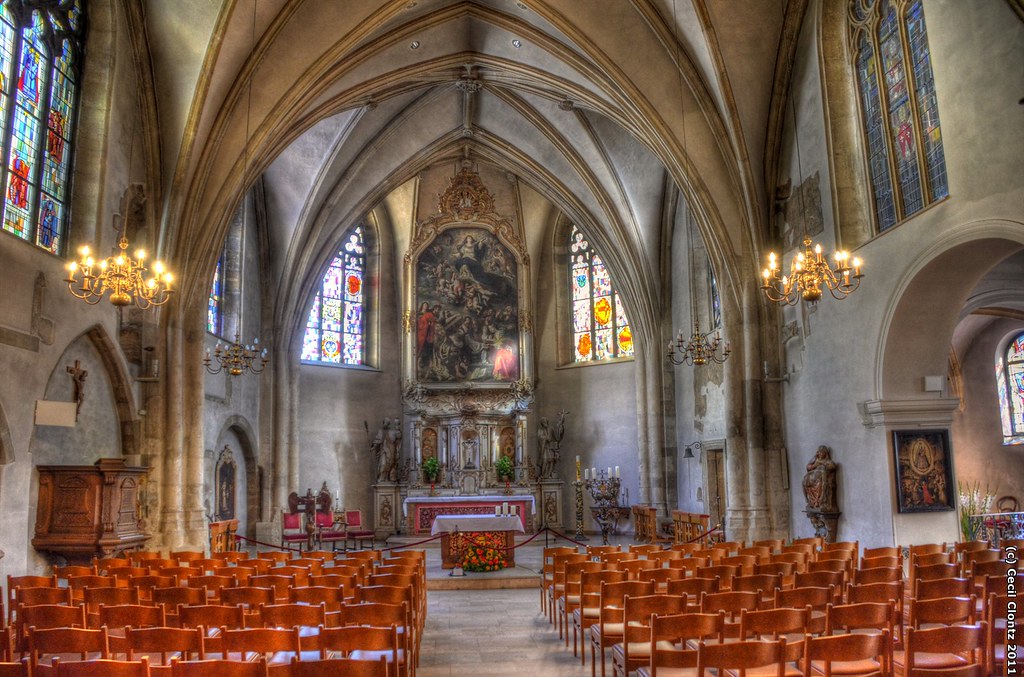
Trinity Church (Protestant Church), has been used since 1817. It is on Rue de la Congrégation in the old town. During the siege of the city by the French in 1684, the church and monastery were bombarded and destroyed, but then rebuilt. Until this time, a crypt under the church was used as a burial site. In 1817, the congregation church was rebuilt by the State as a garrison church for the Protestants among the Prussian garrison troops. Around this military community, a Protestant civil community emerged, composed of civil servants, soldiers, craftsmen, and guest workers.
In 1890, after the Nassau-Weilburg dynasty took over the Luxembourg throne and Trinity Church became the church of Luxembourg’s ruling dynasty. The Grand Duke donated three stained-glass windows in 1901 on the east wall, the altar, the sacristy, the pulpit, the monarch’s box, the baptismal font and the chandelier.
On Adolphe’s death, his son William IV married a Catholic. The marriage agreement stipulated that all male children would be raised Protestant, and all females would be raised Catholic. The couple had six daughters, and thus the ruling house of Luxembourg became Catholic.
Notre-Dame Cathedral is the Roman Catholic Cathedral of Luxembourg City, started in 1613. It is a good example of late Gothic architecture. At the end of the 18th century, the church received the miraculous image of the Maria Consolatrix Afflictorum, the patron saint of both the city and the nation. Around 50 years later, the church was consecrated as the Church of Our Lady and in 1870, it was elevated by Pope Pius IX to the Cathedral of Notre-Dame.
Monument of Remembrance, usually known by the nickname of the Gëlle Fra (Luxembourgish for ‘Golden Lady’), is a war memorial dedicated to the thousands of Luxembourgers who volunteered for service in the armed forces of the Allied Powers during both World Wars and the Korean War.
The centrepiece of the monument is a 21-meter-tall granite obelisk. Atop of the obelisk stands a gilded bronze statue representing Nike, goddess of victory, or “Queen of Freedom” (Friddenskinnigin in Luxembourgish), holding out laurel wreaths as if placing it upon the head of the nation. At the foot of the obelisk are two (ungilded) bronze figures, representing those Luxembourgish soldiers who volunteered to serve France; one lies at the base of the statue, having died in service of his country, whilst the other sits, mourning his dead compatriot. The monument was inaugurated in 1923
The inscriptions at the base of the monument include one in French that honours the Luxembourgeois soldiers who took part in the 1914-18 war, on the battlefields of the Marne, the Aisne, and the Somme, and in Artois, Champagne and at Verdun.
During WWI, Luxembourg was neutral but was occupied by Germany. In total, 3,700 Luxembourgian nationals served in the French army, of whom, 2,000 died. As Luxembourg’s pre-war population was only 266,000, this death toll amounted to more than 1% of the entire national population, which is a relatively greater percentage than many combatant nations.
When Luxembourg was occupied by Nazi forces in World War II, the Germans dismantled the memorial on 21 October 1940. Several portions of the memorial were rescued, and after the war, the monument was partially restored. The Gëlle Fra herself however remained unaccounted for until January 1980 when she was found hidden beneath the main stand of the national football stadium. Later additions were made to honour Luxembourger forces who had served in World War II and the Korean War.
The statue of the Gilded Lady was removed from the obelisk and exhibited at the entrance of the Luxembourg pavilion of the Expo 2010 World Exhibition in Shanghai.
Day 3 in Luxembourg had me seeing everything outside the centre.
Villa Vauban Museum. A 19th-century bourgeois building located in a park west of the centre, it houses the collections of the City of Luxembourg, mainly Dutch and 19th-century French history paintings. Two special exhibits of modern sculpture and art complemented the permanent one. Free
KIRSHBERG. To get to Kirchberg, descend the elevator accessed just north of Boulevard Royal, down to the valley floor in Pfaffenthal, turn left for 200m and catch the elevator up to the base of the funicular. The funicular is a little underwhelming – it is very short but saves a climb. The entrance is about 400m south of the Opera House.
MUDAM – National Museum of Modern Art Grand-Duc Jean. Housed in a spectacular building, this is typical modern art. The only exhibit I liked was the four huge truck tires meticulously carved in Chinese designs. Free on a Saturday.
Fort Thüngen In the Kirchberg quarter, most of the original fortress was demolished after the 1867 Treaty of London, which demanded the demolition of Luxembourg City’s numerous fortifications. The three towers and the foundations of the rest of the fort were all that remained. During the 1990s, the site was reconstructed in its entirety, in parallel with the development of the site for the construction of the Mudam. After being fully restored, the building was reopened in 2012 as Muséde Dräi Eechelen.
Musée Dräi Eechelen (Museum of the Fortress). Full of maps, portraits of famous Luxembourgians, weapons, uniforms and scale models, it tells the complete story of the city and country. Not really worth the price. €5
Statue of deer doing it missionary style in Drei Eechelen Park.
GRUND
Neumünster Abbey is a public meeting place and cultural centre, located in the Grund district of Luxembourg City. After the original Benedictine abbey on the Altmünster Plateau had been destroyed in 1542, the monks built a new abbey or “Neumünster” in 1606 in the Grund. This in turn was destroyed by fire in 1684 but was rebuilt on the same site in 1688 and extended in 1720. After the French Revolution, it served as a police station and prison before becoming a barracks for the Prussians after Napoleon’s defeat in 1815. In 1867, it once again became a state prison.
During World War II, the Nazis used the abbey to imprison political resisters to their occupation of Luxembourg. Among the most notable of those political prisoners was Luxembourg’s best-known sculptor Lucien Wercollier.
Since 1997, it has been the home of the European Institute of Cultural Routes.
Following extensive renovation works, Neumünster was opened in 2004 as a meeting place and a cultural centre, hosting concerts, exhibitions, and seminars. The abbey is also now home to the Lucien Wercollier Cloister, where many works from the sculptor’s private collection are permanently displayed. There are two floors of art, mainly sculpture but also a large collection of modern art.
MNHN – National Museum of Natural History. About 100m from the front door of Neumünster Abbey, it has the usual range of stuffed animals, not all in nice dioramas. The highlight was “Michael Benson – Other Worlds – Visions of Our Solar System, lots of amazing photos. €5
Gare Central (Central Train Station). The old wooden station was replaced by the modern building between 1907 and 1913.
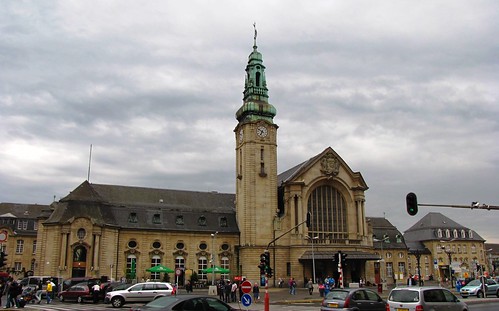
SOUTH LUXEMBOURG
Musee de Vin – Ehnen. Ihnen is about 21 km SE from the city centre on the banks of the Moselle River. The museum is only open from April 1-October 31. The drive here was very rural. Then it was lovely following the river (and the German border) with no traffic to Schengen. Vineyards were everywhere on both sides of the valley.
European Museum – Schengen. This small town sits at the point where Germany, France and Luxembourg meet. The original meetings to form the EU were held here. This small museum gives that original history. 12 video terminals tell the story of the Schengen visa agreement.
Roeser-Bann National Park. Established in 1994, this is a 2,100-hectare protected nature reserve near Eche-sur-Alzette. It is cross-crossed by beautiful hiking paths, cycling tracks as well as a Nordic Walking Park.
ECHE-SUR-ALZETTE
St Henri Church. Roman Catholic church
National Resistance Museum. The main building was under renovation and the small exhibits showed the essence of the resistance and the Holocaust and how it affected Luxembourgians.
